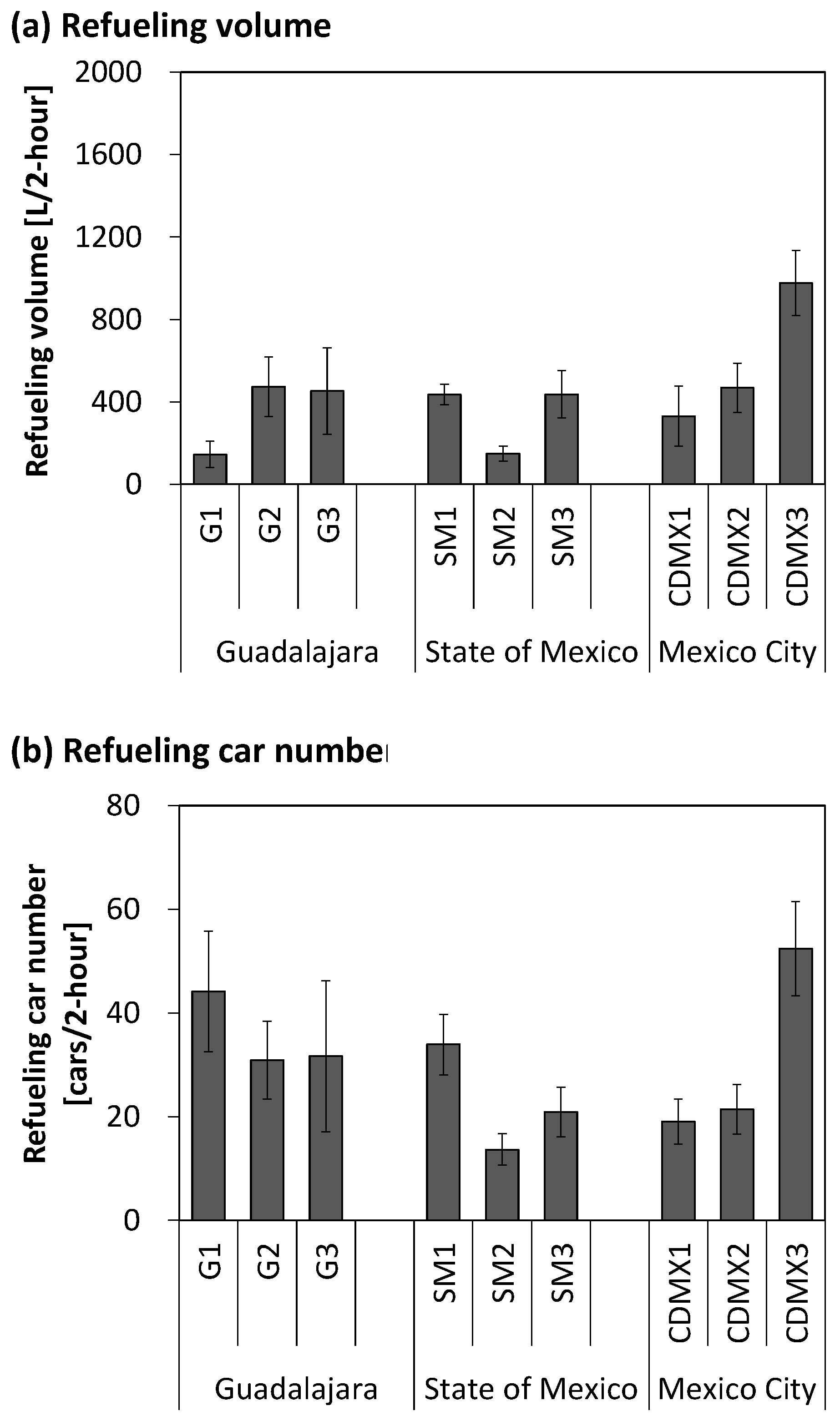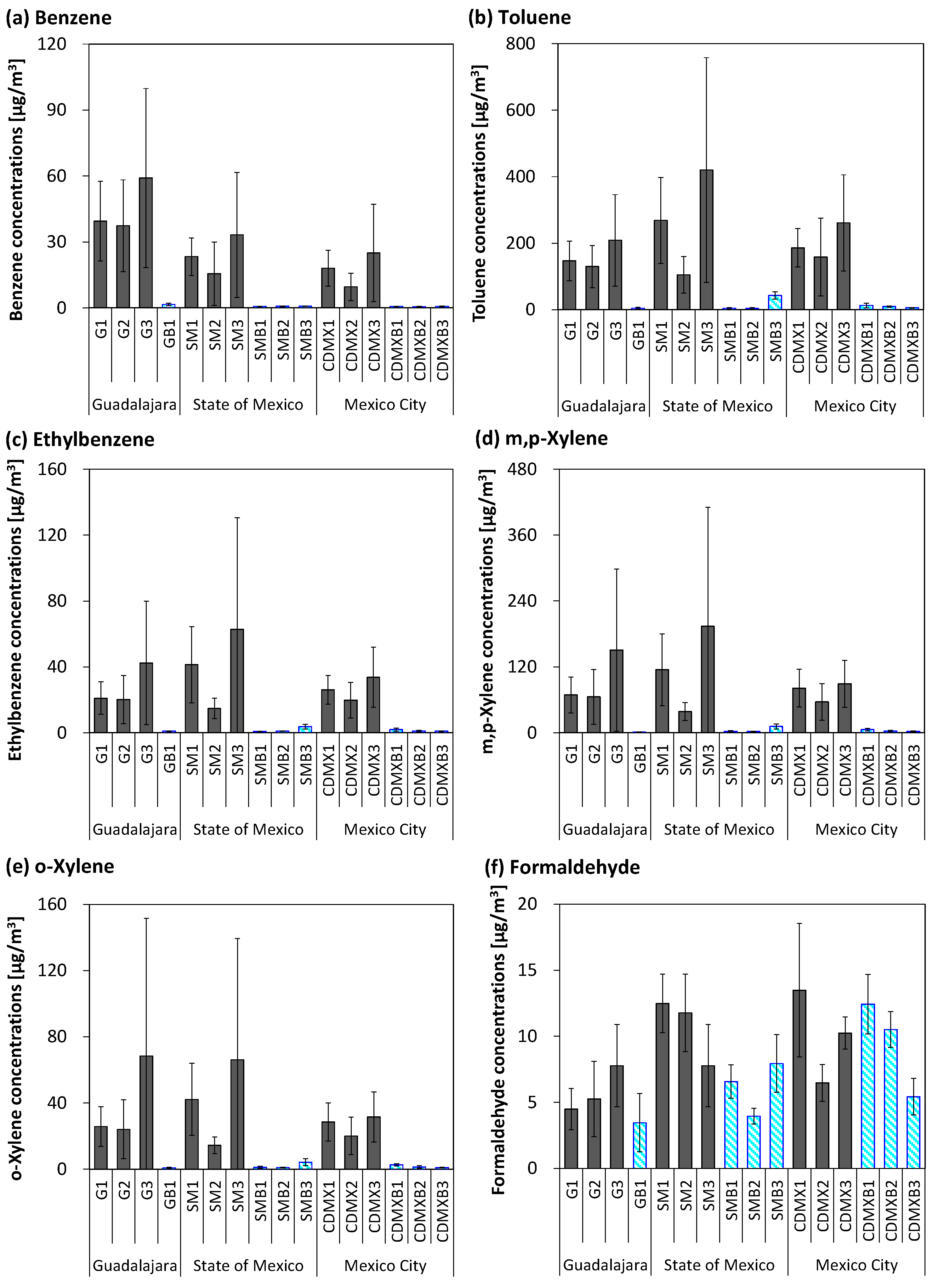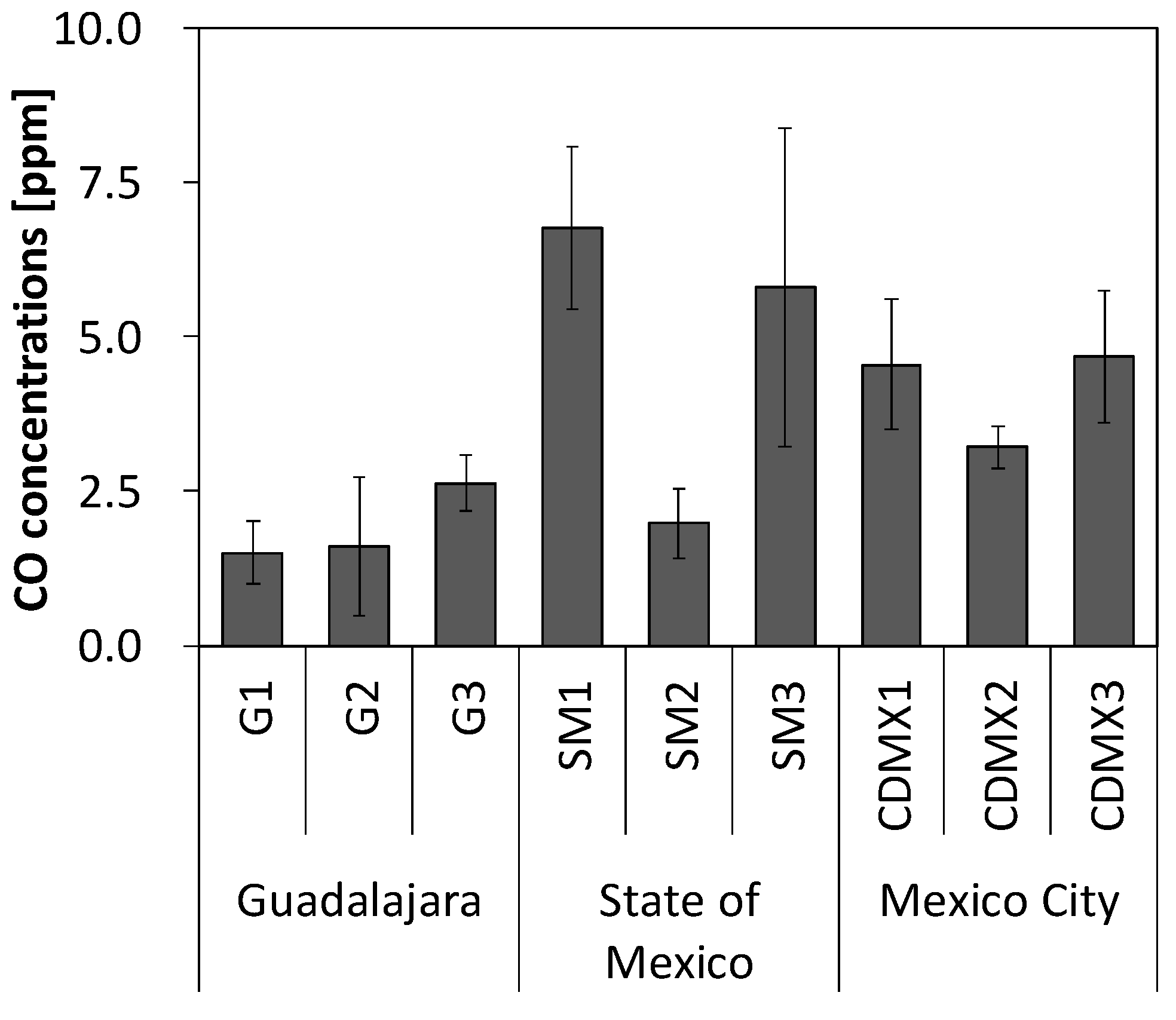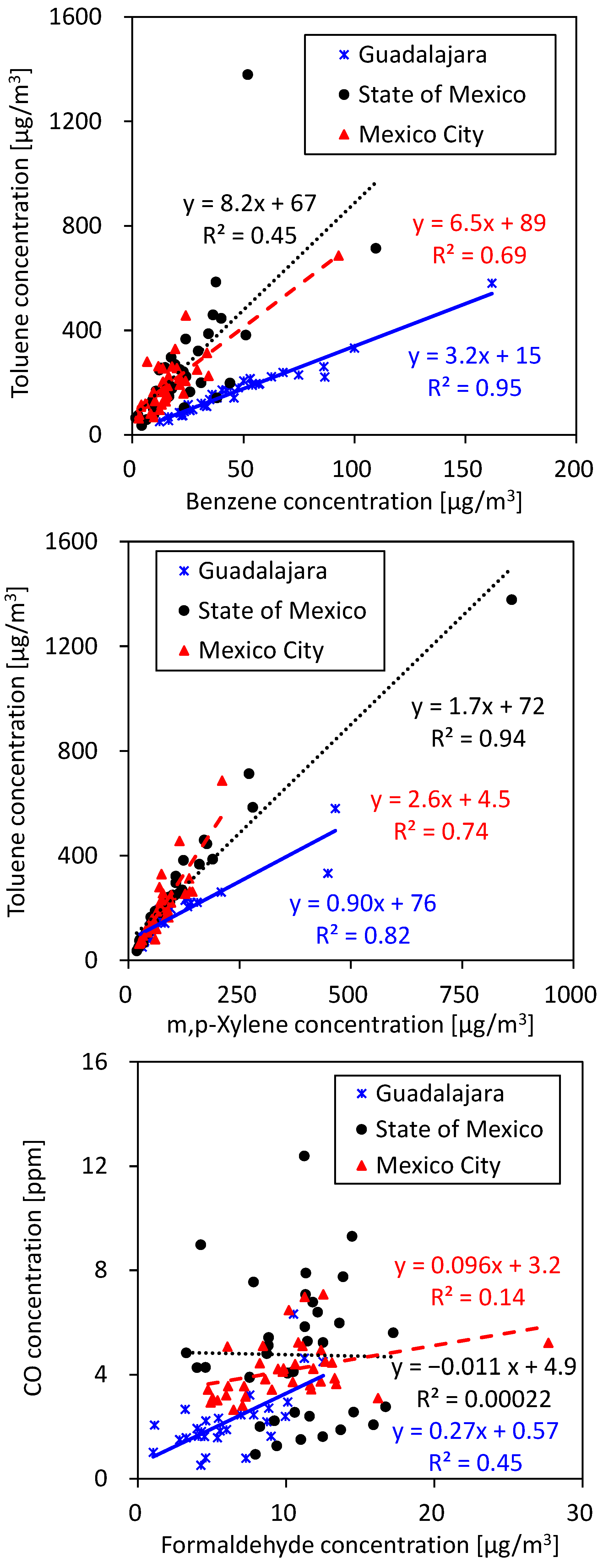Exposure/Risk Assessment of Employees in Gasoline Refueling Stations with and Without the Efficacy of Vapor Recovery Systems in Mexico
Abstract
:1. Introduction
2. Materials and Methods
2.1. Survey Area and Period
2.2. Sampling and Analysis
2.3. Risk Assessment of Employees
3. Results
3.1. Refueling Volume and Number of Cars
3.2. BTEX and Aldehydes
3.3. CO
3.4. PM2.5
3.5. Risk Assessment of Employees
4. Discussion
5. Conclusions
Supplementary Materials
Author Contributions
Funding
Institutional Review Board Statement
Informed Consent Statement
Data Availability Statement
Conflicts of Interest
References
- International Agency for Research on Cancer (IARC). IARC Monographs on the Evaluation of Carcinogenic Risks to Humans, Volumes 100F, Chemical Agents and Related Occupations; IARC: Lyon, France, 2012; pp. 249–294. [Google Scholar]
- Agency for Toxic Substances and Disease Registry (ATSDR). Toxicological Profile for Xylene; U.S. Department of Health and Human Services: Atlanta, GA, USA, 2007.
- Agency for Toxic Substances and Disease Registry (ATSDR). Toxicological Profile for Ethylbenzene; U.S. Department of Health and Human Services: Atlanta, GA, USA, 2010.
- Agency for Toxic Substances and Disease Registry (ATSDR). Toxicological Profile for Toluene; U.S. Department of Health and Human Services: Atlanta, GA, USA, 2017.
- Japan Society for Occupational Health (JSOH). Ethylbenzene. Sangyo Eiseigaku Zasshi 2001, 43, 120–122. (In Japanese) [Google Scholar] [CrossRef]
- Japan Society for Occupational Health (JSOH). Xylene. Sangyo Eiseigaku Zasshi 2001, 43, 122–126. (In Japanese) [Google Scholar]
- Japan Society for Occupational Health (JSOH). Toluene. Sangyo Eiseigaku Zasshi 2013, 55, 257–258. (In Japanese) [Google Scholar]
- Agency for Toxic Substances and Disease Registry (ATSDR). Toxicological Profile for Formaldehyde; U.S. Department of Health and Human Services: Atlanta, GA, USA, 1999.
- Agency for Toxic Substances and Disease Registry (ATSDR). Public Health Statement Formaldehyde; Department of Health and Human Services: Atlanta, GA, USA, 2008. [Google Scholar]
- Japan Society for Occupational Health (JSOH). Formaldehyde. Sangyo Eiseigaku Zasshi 2007, 49, 175–181. (In Japanese) [Google Scholar]
- Agency for Toxic Substances and Disease Registry (ATSDR). Addendum to the Toxicological Profile for CO; U.S. Department of Health and Human Services: Atlanta, GA, USA, 2012.
- Japan Society for Occupational Health (JSOH). CO: Reproductive effect. Sangyo Eiseigaku Zasshi 2014, 56, 202–203. (In Japanese) [Google Scholar]
- Ministry of the Environment (MOE). Report of Advisory Committee on Health Effects Assessment of Fine Particle Matter. Atmospheric Environment Committee of Central Environment Council. 2008. Available online: http://www.env.go.jp/air/report/h20-01/ (accessed on 18 July 2019). (In Japanese).
- Xiong, Y.; Bari, A.; Xing, Z.; Du, K. Ambient volatile organic compounds (VOCs) in two coastal cities in western Canada: Spatiotemporal variation, source apportionment, and health risk assessment. Sci. Total Environ. 2020, 706, 135970. [Google Scholar] [CrossRef] [PubMed]
- Xiong, Y.; Partha, D.; Prime, N.; Smith, S.J.; Mariscal, N.; Salah, H.; Huang, Y. Long-term trends of impacts of global gasoline and diesel emissions on ambient PM2.5 and O3 pollution and the related health burden for 2000–2015. Environ. Res. Lett. 2022, 17, 104042. [Google Scholar] [CrossRef]
- Ekpenyong, C.E.; Asuquo, A.E. Recent advances in occupational and environmental health hazards of workers exposed to gasoline compounds. Int. J. Occup. Med. Environ. Health 2017, 30, 1–26. [Google Scholar] [CrossRef] [PubMed]
- Shearston, J.A.; Hilpert, M. Gasoline Vapor Emissions During Vehicle Refueling Events in a Vehicle Fleet Saturated With Onboard Refueling Vapor Recovery Systems: Need for an Exposure Assessment. Front. Public Health 2020, 8, 18. [Google Scholar] [CrossRef] [PubMed]
- Shinohara, N.; Okazaki, Y.; Mizukoshi, A.; Wakamatsu, S. Exposure to benzene, toluene, ethylbenzene, xylene, formaldehyde, and acetaldehyde in and around gas stations in Japan. Chemosphere 2019, 222, 923–931. [Google Scholar] [CrossRef]
- Jia, C.; Fu, X.; Chauhan, B.; Xue, Z.; Kedia, R.J.; Mishra, C.S. Exposure to volatile organic compounds (VOCs) at gas stations: A probabilistic analysis. Air Qual. Atmos. Health 2022, 15, 465–477. [Google Scholar] [CrossRef]
- Scheepers, P.T.; de Werdt, L.; van Dael, M.; Anzion, R.; Vanoirbeek, J.; Duca, R.C.; Creta, M.; Godderis, L.; Warnakulasuriya, D.; Devanarayana, N.M. Assessment of exposure of gas station attendants in Sri Lanka to benzene, toluene and xylenes. Environ. Res. 2019, 178, 108670. [Google Scholar] [CrossRef] [PubMed]
- Esmaelnejad, F.; Hajizadeh, Y.; Pourzamani, H.; Amin, M. Monitoring of benzene, toluene, ethyl benzene, and xylene isomers emission from Shahreza gas stations in 2013. J. Environ. Health Eng. 2015, 1, 17. [Google Scholar] [CrossRef]
- Cruz, L.; Alves, L.; Santos, A.; Esteves, M.; Gomes, Í.; Nunes, L. Assessment of BTEX concentrations in air ambient of gas stations using passive sampling and the health risks for workers. J. Environ. Protect. 2017, 8, 12–25. [Google Scholar] [CrossRef]
- Tunsaringkarn, T.; Siriwong, W.; Rungsiyothin, A.; Nopparatbundit, S. Occupational exposure of gasoline station workers to BTEX compounds in Bangkok, Thailand. Int. J. Occup. Environ. Health 2012, 3, 117–125. [Google Scholar]
- Patton, A.N.; Levy-Zamora, M.; Fox, M.; Koehler, K. Benzene Exposure and Cancer Risk from Commercial Gasoline Station Fueling Events Using a Novel Self-Sampling Protocol. Int. J. Environ. Res. Public Health 2021, 18, 1872. [Google Scholar] [CrossRef]
- Gao, X.; Wang, P.; Hu, Y.; Cao, Y.; Yuan, W.; Luan, Y.; Quan, C.; Zhou, Z.; Zou, H. Exposure Concentrations and Inhalation Risk of Submicron Particles in a Gasoline Station-A Pilot Study. Sustainability 2023, 15, 9455. [Google Scholar] [CrossRef]
- Sultana, D.; Hoover, S. Analysis of gasoline-related pollutant exposures and risks in California between 1996 and 2014. J. Expo. Sci. Environ. Epidemiol. 2023, 34, 518–528. [Google Scholar] [CrossRef]
- Marr, L.C.; Morrison, G.C.; Nazaroff, W.W.; Harley, R.A. Reducing the risk of accidental death due to vehicle-related carbon monoxide poisoning. J. Air Waste Manag. Assoc. 1998, 48, 899–906. [Google Scholar] [CrossRef] [PubMed]
- Majstorovic, A.; Babic, V.; Todic, M. Carbon monoxide in the process of uncontrolled combustion—Occurrence, hazards and first aid. Int. Conf. Appl. Sci. 2020, 1426, 012008. [Google Scholar] [CrossRef]
- May, A.A.; Nguyen, N.T.; Presto, A.A.; Gordon, T.D.; Lipsky, E.M.; Karve, M.; Gutierrez, A.; Robertson, W.H.; Zhang, M.; Brandow, C.; et al. Gas- and particle-phase primary emissions from in-use, on-road gasoline and diesel vehicles. Atmos. Environ. 2014, 88, 247–260. [Google Scholar] [CrossRef]
- Streva, E.R.; Pasa, V.M.D.; Sodré, J.R. Aging effects on gasoline-ethanol blend properties and composition. Fuel 2011, 90, 215–219. [Google Scholar] [CrossRef]
- Metropolitan Environmental Commission. Program to Improve Air Quality of the Metropolitan Area Valley of Mexico 2011–2020; Mexico City Government: Mexico City, Mexico, 2008. [Google Scholar]
- Shinohara, N.; Ángeles, F.; Basaldud, R.; Cardenas, B.; Wakamatsu, S. Reductions in commuter exposure to volatile organic compounds in Mexico City due to the environmental program ProAire 2002–2010. J. Expo. Sci. Environ. Epidemiol. 2017, 28, 339–345. [Google Scholar] [CrossRef] [PubMed]
- Cruzado, M.J.A.; Ramirez, I.V.; Suarez, C.M. Revision of Program to Improve Air Quality (ProAire) Jalisco 2014–2020 and Recommendations to Achieve Air Quality Impacts in the Gadalajara Metropolitan Area; Government of the State of Jalisco, Secretary of Environment and Territorial Development, 2018. Available online: https://semadet.jalisco.gob.mx/sites/semadet.jalisco.gob.mx/files/revision_y_recomendaciones_del_programa_para_mejorar_la_calidad_del_aire_2014-2020.pdf (accessed on 2 December 2024). (In Spanish).
- Shiohara, N.; Fernández-Bremauntz, A.A.; Jiménez, S.B.; Yanagisawa, Y. The Commuters’ Exposure to Volatile Chemicals and Carcinogenic Risk in Mexico City. Atmos. Environ. 2005, 39, 3481–3489. [Google Scholar] [CrossRef]
- U.S. EPA: U.S. Environmental Protection Agency. EPA 40 CFR Part 51: Air Quality: Widespread Use for Onboard Refueling Vapor Recovery and Stage II Waiver. Environmental Protection Agency. Fed. Regist. 2012, 77, 28772–28782. [Google Scholar]
- Fung, F.; Maxwell, B. Onboard Refueling Vapor Recovery: Evaluation of the ORVR Program in the United States. Working Paper (2011–12) of International Council on Clean Transportation. 2011. Available online: https://theicct.org/wp-content/uploads/2021/06/ORVR_v4_0.pdf (accessed on 2 December 2024).
- Álvarez, V.M.; Lara, J.d.J.F.; Moreno, A.H. Evaluation and Following the Program to Improve Air Quality in the Metropolitan Area of Mexico Valley 2002–2010; Metropolitan Autonomous University-Azcapotzalco: Azcapotzalco, Mexico, 2010. [Google Scholar]
- Huy, L.N.; Oanh, N.T.K. Emission control for volatile organic compounds from gasoline stations and implication on ozone-forming potential. Atmos. Pollut. Res. 2020, 11, 87–98. [Google Scholar] [CrossRef]
- U.S. Environmental Protection Agency (U.S. EPA). Compendium of Methods for the Determination of Toxic Organic Compounds in Ambient Air. Second Edition Compendium Method TO-17. EPA/625/R-96/010b Determination of Volatile Organic Compounds in Ambient Air Using Active Sampling Onto Sorbent Tubes. Washington, DC. 1999. Available online: https://www.epa.gov/sites/default/files/2019-11/documents/to-17r.pdf (accessed on 2 December 2024).
- U.S. Environmental Protection Agency (U.S. EPA). Method 8315A (SW-846): Determination of Carbonyl Compounds by High Performance Liquid Chromatography (HPLC), Revision 1. Washington, DC. 1996. Available online: https://www.epa.gov/sites/default/files/2015-07/documents/epa-8315a.pdf (accessed on 2 December 2024).
- U.S. Environmental Protection Agency (U.S. EPA). Guidelines for Carcinogen Risk Assessment, EPA/630/P-03/001F, Washington, DC, USA. 2005. Available online: https://www.epa.gov/sites/default/files/2013-09/documents/cancer_guidelines_final_3-25-05.pdf (accessed on 2 December 2024).
- U.S. Environmental Protection Agency (U.S. EPA). Integrated Risk Information System (IRIS) U.S. Environmental Protection Agency, Chemical Assessment Summary-Quantitative Estimate of Carcinogenic Risk from Inhalation Exposure-Benzene; CASRN 71-43-2. 2000. Available online: https://iris.epa.gov/static/pdfs/0276_summary.pdf (accessed on 5 December 2024).
- Ortiz, E.; Alemón, E.; Romero, D.; Arriaga, J.L.; Olaya, P.; Guzmán, F.; Ríos, C. Personal exposure to benzene, toluene and xylene in different microenvironments at the Mexico City metropolitan zone. Sci. Total Environ. 2002, 287, 241–248. [Google Scholar] [CrossRef] [PubMed]
- Bravo, H.; Sosa, R.; Sánchez, P.; Bueno, E.; González, L. Concentrations of benzene and toluene in the atmosphere of the southwestern area at the Mexico City Metropolitan Zone. Atmos. Environ. 2002, 36, 3843–3849. [Google Scholar] [CrossRef]
- Ministry of Economy, Trade and Industry (METI). Manual for Calculation of PRTR Emission Amount. 2018. Available online: https://www.meti.go.jp/policy/chemical_management/law/prtr/PRTRmunyuaru.html (accessed on 18 July 2019). (In Japanese).
- Ludykar, D.; Westerholma, R.; Almen, U.J. Cold start emissions at +22, −7 and −20 °C ambient temperatures from a three-way catalyst TWC car: Regulated and unregulated exhaust components. Sci. Total Environ. 1999, 235, 65–69. [Google Scholar] [CrossRef]
- Kountouriotis, A.; Aleiferis, P.G.; Charalambides, A.G. Numerical investigation of VOC levels in the area of petrol stations. Sci. Total Environ. 2014, 470–471, 1205–1224. [Google Scholar] [CrossRef]
- Travis, C.C.; Richter, S.A.; Crouch, E.A.; Wilson, R.; Klema, E.D. Cancer risk management A review of 132 federal regulatory decisions. Environ. Sci. Technol. 1987, 21, 415–420. [Google Scholar] [CrossRef] [PubMed]
- Chaiklieng, S. Risk assessment of workers’ exposure to BTEX and hazardous area classification at gasoline stations. PLoS ONE 2021, 16, e0249913. [Google Scholar] [CrossRef] [PubMed]
- CalEPA: California Environmental Protection Agency. Air Toxics Hot Spots Program Guidance Manual. Risk Assessment Guidelines: Guidance Manual for Preparation of Health Risk Assessments. 2015. Available online: https://oehha.ca.gov/media/downloads/crnr/2015guidancemanual.pdf (accessed on 2 December 2024).






| Benzene Exposure [μg/m3] | Estimated Excess Cancer Risk [Unitless] | |||
|---|---|---|---|---|
| Mean | Max | Mean | Max | |
| Guadalajara | 45 | 1.6 × 102 | 1.2–4.2 × 10−5 | 0.42–1.5 × 10−4 |
| State of Mexico | 24 | 1.1 × 102 | 0.63–2.2 × 10−5 | 0.29–1.0 × 10−4 |
| Mexico City | 18 | 93 | 0.46–1.6 × 10−5 | 2.4–8.6 × 10−5 |
Disclaimer/Publisher’s Note: The statements, opinions and data contained in all publications are solely those of the individual author(s) and contributor(s) and not of MDPI and/or the editor(s). MDPI and/or the editor(s) disclaim responsibility for any injury to people or property resulting from any ideas, methods, instructions or products referred to in the content. |
© 2024 by the authors. Licensee MDPI, Basel, Switzerland. This article is an open access article distributed under the terms and conditions of the Creative Commons Attribution (CC BY) license (https://creativecommons.org/licenses/by/4.0/).
Share and Cite
Shinohara, N.; García, J.J.F.Á.; Reyes, M.M.; Jiménez, B.G.; Cruz, R.B.; Gonzalez, B.C.; Wakamatsu, S. Exposure/Risk Assessment of Employees in Gasoline Refueling Stations with and Without the Efficacy of Vapor Recovery Systems in Mexico. Int. J. Environ. Res. Public Health 2025, 22, 10. https://doi.org/10.3390/ijerph22010010
Shinohara N, García JJFÁ, Reyes MM, Jiménez BG, Cruz RB, Gonzalez BC, Wakamatsu S. Exposure/Risk Assessment of Employees in Gasoline Refueling Stations with and Without the Efficacy of Vapor Recovery Systems in Mexico. International Journal of Environmental Research and Public Health. 2025; 22(1):10. https://doi.org/10.3390/ijerph22010010
Chicago/Turabian StyleShinohara, Naohide, Jose Juan Felipe Ángeles García, Miguel Magaña Reyes, Becki Gatica Jiménez, Roberto Basaldud Cruz, Beatriz Cardenas Gonzalez, and Shinji Wakamatsu. 2025. "Exposure/Risk Assessment of Employees in Gasoline Refueling Stations with and Without the Efficacy of Vapor Recovery Systems in Mexico" International Journal of Environmental Research and Public Health 22, no. 1: 10. https://doi.org/10.3390/ijerph22010010
APA StyleShinohara, N., García, J. J. F. Á., Reyes, M. M., Jiménez, B. G., Cruz, R. B., Gonzalez, B. C., & Wakamatsu, S. (2025). Exposure/Risk Assessment of Employees in Gasoline Refueling Stations with and Without the Efficacy of Vapor Recovery Systems in Mexico. International Journal of Environmental Research and Public Health, 22(1), 10. https://doi.org/10.3390/ijerph22010010






